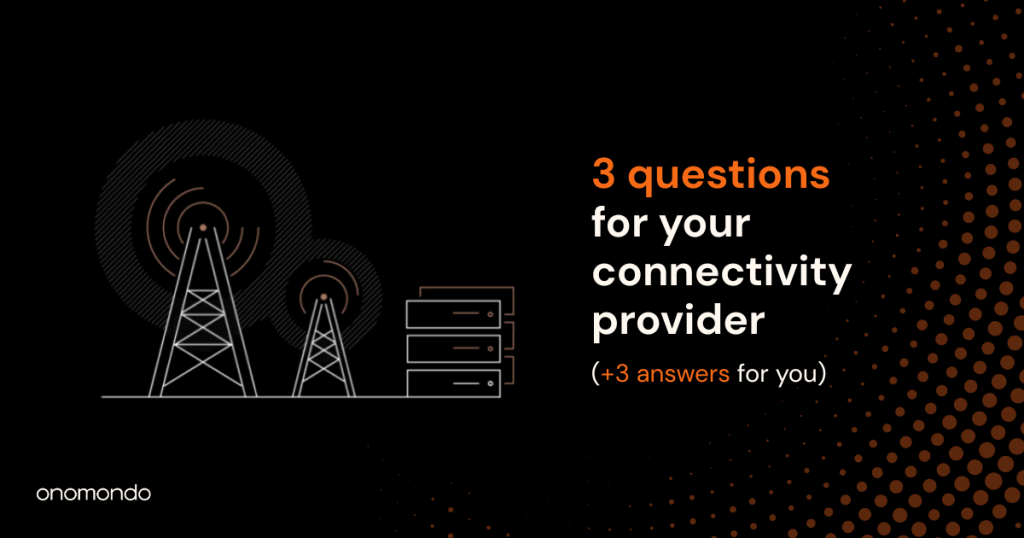The Internet of Things (IoT) is arguably the area with the most potential for innovation in the telecom industry today. It has far-reaching applications and is predicted to have significant implications for the future of business and society. Such is the extent of innovation within IoT that it happens in practically all parts of the value chain, from the actual hardware in devices right through to application and data layers.
However, despite the astronomical potential of IoT, the telecom industry has fallen behind in helping this technology succeed, leaving IoT projects to struggle with inefficient connectivity solutions.
The approach from the telecoms industry has largely been to try and use existing cellular network systems and supply chains to service the IoT sector, but the specific demands of IoT solutions have unfortunately been underserved as a consequence.
Table of Contents
Opportunities in an underserved market
Thankfully, new opportunities now exist that deserve some attention. In this post, we’ll go through what those new opportunities are and how to distinguish between them.
Technical momentum
Technical momentum is the theory of how a new technology becomes a natural part of society. It combines two theories into one idea. The first theory is that when new technology becomes commonplace, it permanently alters that society. The second theory is that it is actually people who determine changes to a particular technology and not the other way around.
In combining these two theories, technical momentum hypothesises that when a technology is just beginning to emerge — as IoT is — society is influencing the technology more than the technology is influencing them. As time goes by, this reverses, and the now mature technology influences society more and irreversibly changes it.
Because IoT is still in its early stages, we are seeing companies trying to force the way IoT evolves, slowing down its adoption and ease of implementation.
The following are some of the ways in which the current IoT connectivity industry is inadvertently holding IoT back.
Innovation focused on smartphone connectivity
Trying to use traditional cellular network systems for IoT connectivity means some of IoT’s specific needs get overlooked.
Cellular connectivity is primarily geared towards smartphones, and it has been that way for a long time. Rather than focusing on solutions that IoT needs in order to thrive — such as low power consumption, cost efficiency, global coverage, etc. — traditional providers are working on improving upload and download speeds and the number of connections the average customer requires in what is typically oriented towards a national market.
These are the same things that the telecom industry has been innovating on for years, and since smartphones likely aren’t going anywhere anytime soon, there’s no reason for providers to focus on anything else. We’re unlikely to see traditional connectivity providers offer realistic and innovative IoT solutions until the IoT market reaches a more mature point. Therefore, it’s largely up to IoT-centric companies to fill in the gaps in the meantime.

A market focused on traditional telecom
Because IoT is still to reach its full potential, the market is focused on traditional telecom practices and structures. One example of this is how most telecom companies favour competition over collaboration.
Businesses are typically territorial with their network coverage, which makes it difficult for any network to offer true global coverage instead of a traditional limited roaming setup. And while a lack of global coverage doesn’t have much of an impact on traditional telecom needs, many IoT projects — especially larger ones — struggle without the reliability of a truly global network.
To some extent, eUICC acts as a workaround to the problems that territorial business practices create. It allows a single SIM card to store multiple network profiles so that one device can switch between various networks. The idea behind this is that an IoT device could strategically pick operators that cover different regions, thereby creating a patchwork global network out of separate networks.
But this is far from ideal as managing multiple providers per device is complicated, costly and can be unreliable. The technology also has its own limitations; some are commercially related, while others occur from the way the standards have been developed.
Read more about eSIM/eUICC: What are eSIMs? And when to use them for IoT.
Another downfall of the traditional telecom industry is a lack of permanent roaming. In traditional telecom, a device can only roam internationally for a fixed amount of time before it has to return to its home network; otherwise it risks losing connectivity altogether. Since many IoT devices are nomadic by nature, roaming limitations can create serious complications for the longevity of an IoT project.
Repurposing mobile connectivity techniques
Traditional cellular solutions still have a lot to offer the IoT industry. It’s fast, standardised, has a reliable infrastructure, and has already been through decades of maturation.
That doesn’t mean that traditional connectivity techniques can simply be repurposed for IoT. And yet, that’s precisely what several telecom providers are doing; marketing connectivity solutions to IoT projects without actually implementing any IoT-specific features.

One example of this is the way that connectivity providers charge for IoT projects. Rather than simply charging for the data used, IoT projects are also charged for how many SIM cards they have in use, regardless of whether or not those SIMs actually use any data within a month’s billing cycle. While this pricing model works with personal devices where this cost is small compared to its total cost of service, it’s unsustainable in the IoT market with its typically very low traffic consumption per device.
Many providers also have little to offer IoT in the way of network control. Rather than having end-to-end control over their networks, providers partner with other networks through roaming to increase their coverage, purchase SIMs from wholesalers without having crucial access to the SIM keys (e.g. the subscriber authentication key (Ki key) and Derived operator code (OPC key)) themselves, and use eSIM management platforms that are owned and created by another company.
The result is that IoT projects who partner with these kinds of providers have little flexibility, control, or transparency about the way that their devices are actually connected or managed within the network.
What about NB-IoT?
While the telecom industry has been fairly slow to come up with solutions to the challenges of IoT connectivity, the network side of things has experienced some radically new ideas in this area. One of these ideas is NB-IoT.
The “NB” in “NB-IoT” is short for narrowband, and it refers to a relatively untapped frequency that can keep devices connected with one another. These NB channels have traditionally been overlooked by mobile networks because of their limitations. Narrowband is only capable of sending very small amounts of data at a time, which would result in ridiculously slow internet speeds on mobile devices.
In the world of IoT, though, it’s often the case that each device only needs to send a small amount of data at a time, which means that NB technology would seem like the western frontier of mobile connectivity — an untapped solution to IoT’s needs.
What about Sigfox, LoRaWAN and Weightless?
Sigfox (2009) has been around for a decade, while other new network solutions have also sprung up in more recent years, like LoRaWAN (2015) and Weightless (2012).
These networks aimed to fix the following problems within IoT:
- Power consumption
- An IoT-centric pricing model
- New network and collaboration structures
While each of these networks has its place within the IoT industry, they still have limitations, such as using unregulated frequencies and are still early in development. As a result, they can suffer from noise within their frequency ranges that create interference, as well as still lack infrastructure for truly global IoT projects.
Adapting to the needs of IoT
It’s unfortunate that so many telecom providers aren’t investing more into IoT connectivity, as cellular has so much to offer the IoT industry. Many of the things that make cellular great are critical to an IoT project’s success. It’s a standardized network with plenty of trusted suppliers around the world, it’s global and — most importantly — it’s already developed.
What is missing in the telecom industry, however, is a focus to overcome the obstacles of IoT connectivity and a concerted effort to innovate for the sector, both commercially and technologically.
Designing an IoT SIM
In order for a SIM card to be more than just a standard data SIM — a SIM made for IoT — it would need to be completely rethought from an IoT perspective.
First, it would need to provide users with services that are unique to IoT’s needs. This includes features like permanent roaming, global connectivity, and full and real time network control as standard.
Second, it would need a pricing model that matches the way the IoT industry works. This would make investing in IoT productivity more practical and sensible for new IoT projects, with much lower business risk to follow.
And third, it would need to be flexible. Every IoT project is different and therefore has different needs. The size, region, goals, and function of an IoT project all have a major impact on how they are going to use their connectivity. While a blanket option works for smartphones, it doesn’t translate to IoT across industry sectors, which leaves IoT projects to patch together a solution themselves using tech like eUICC or increasingly complicated device logic.

It’s possible to mix ‘n’ match
IoT users should be able to mix and match the form factor and architecture of IoT SIMs easily, which would allow companies to focus more on what a device needs and less on the limits of their connectivity.
Embedded sims (MFF2) have a significant place to play in the future of IoT but there is still little transparency in the industry, adding complexity to the purchasing process and in many cases a slower turn around time. Depending on the specific IoT use case, different manufacturing grades of replaceable SIM forms may be completely sufficient (see table below).

Onomondo — A true IoT SIM provider
Within this gap, Onomondo has developed global cellular IoT connectivity that’s built to get the best out of global cellular infrastructure and new IoT connectivity advances.
Combining the powerful tried and true characteristics of cellular data SIMs but with all the flexibility for it to become a true IoT SIM, we support your IoT project to connect at production, ship globally, fit your business model and retain flexibility throughout deployment.






